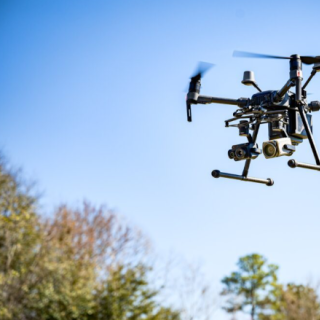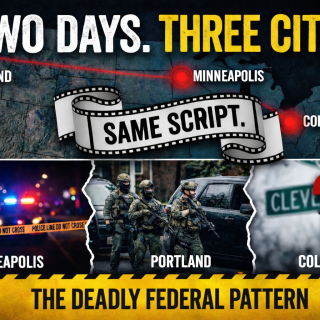Columbus searches in vain for an identity, bouncing ridiculously from Cowtown to Crop Town, Cap City, Arch City, Buckeyeville, Nationwide or Crew City, or Number 14 or 15 (in population rank among U.S. cities). None of those fit the city past or present. I propose another, more appropriate and accurate moniker: the lawless, wild-wild-Midwest. (See my “Columbus’ identity crisis and its media”; “Columbus searches for its Downtown with historical, urbanist, and developers’ blinders”; “Columbus, Ohio, searches to be a city: The myth of the Columbus Way”; “Is Columbus actually a City?”)
The major partners in promoting the lawless, wild-wild-Midwest are a poorly organized and disconnected set of self-promoting public and private entities. The principals are the City of Columbus, the Columbus Police Department (CPD), and its unofficial affiliates, the Columbus Partnership, Columbus Downtown Development Corporation, Columbus Foundation, Columbus Metropolitan Club, Ohio State University, Columbus Dispatch, and other media. (See “Notes on current politics in Columbus and Ohio: Thoughts in response to questions from my editor”; “Columbus city government is undemocratic and disorganized: It’s 2021 and we need a revolution”; “The Columbus Dispatch: The decline of a metropolitan daily newspaper”; “Columbus’ major ‘news media’ against democratic politics and the public”; “WOSU, the nation’s worst NPR affiliate? The challenge of criticizing a self-parody of a ‘news and information’ station.”)
In the stereotypical Columbus Way, these entities court developers and repeat slogans. Columbus is the only city of its size that lacks representative government and has no city manager. It is the most disorganized large U.S. city that I as an urban historian have ever seen. The City Attorney’s police liaison does not support the police enforcing the law; CPD does not consider non-emergency reports to be “a priority”; the City’s 311 system works only part-time and is so understaffed that it barely functions; Code Inspection is even worse. (When the Mayor chose to target the long-standing problem of illegal dumping as his new site for sloganeering, he selected the ineffective CrimeStoppers tip line instead of repairing the failing 311 reporting system or rebuilding CPD.)
Police officers on the street do not always know the law. They are poorly supervised and coordinated. Traffic, parking, trash, and public health are not regularly surveilled. Both inspections and follow-ups to 311 reports are infrequent. Delivery vehicles park in the middle of streets with impunity. Their drivers swear at citizens who remind them of the law. Drivers often ignore stop signs and pedestrians in cross walks. The City shows this neglect physically. The unelected Fraternal Order of Police wields a bigger veto stick than the Mayor or Chief of Police. Changes in CPD procedures come primarily via court rulings.
Insubstantial local efforts are reinforced by the State of Ohio. Led by its right-wing Republican legislative majority and its weak Governor fearful of his primary opponent, together they actively promote gun violence by ignoring both the public and law enforcement (including the FOP and the judiciary) to expand “stand your ground” and permitless, no-training, “open carry” laws. Radically distorting the text and the case history of the Second Amendment, these reckless actions take place as homicides by gunshot soar across all demographics and geographies. They fan the fires of the wild-wild-Midwest.
Crime, assault, shootings, and open-carry and stand-your-ground laws make front-page news in Columbus. Crime in Columbus makes national news. But the underlying foundations for lawless, wild-wild-Midwest Columbus seldom do. However contradictory, Columbus mayors and City Councils make uninformed or misinformed gestures at genuine city problems with empty slogans that lack programs, budgets, and timetables. They are far too many to list.
Immediate past mayor Michael Coleman and current Mayor Andrew Ginther lead by rambling pointlessly before TV cameras and microphones. Their slogans are detached from everyday realities—often along the lines of organizing early evening basketball games for teens, or calling on the public, “if you see something, say something” or “only you can do...”
Instead of thoughtful, researched, and relevant approaches—or even a glance to see what works in other cities—the City and Columbus Police Department say almost nothing about their nationally high, annual record-breaking rates of homicides and gun violence; decline in size, coordination, and operations of the police; no significant gun buyback programs; insufficient attention to jobs, poverty, housing, and education; and a level of violence by police themselves that stands higher than Columbus’ population ranking and led to a federal Department of Justice civil rights investigation. Columbus stands out nationally in homicides committed by on-duty police and percentage of City Police who reside outside their jurisdiction. Citizen input is ignored. Police chiefs change and “reform” becomes a buzzword, but rates do not decline.
Compounding citizens’ lack of confidence and police misconduct, city, county, state, and federal grand juries almost never recommend trials for the frequent killings of civilians by police officers, especially Blacks and Black youths. Correspondingly, CPD seldom responds accountably to the community. In the face of regular outcries, the City offers disproportionately high, $200,000 individual bonuses to lure police to retire at the same time that public safety forces are drastically understaffed. These stand out among the mounting crime problems without responsible supervision, organization, planning and enactment, and funding. I struggle to find any logic or plan.
Neither City leadership, CPD, nor local media respond to national news reports that “‘The Columbus Police Department uses deadly force at a rate higher than the national average, and it uses deadly force in ways that are racially disparate.’ Black people are five times more likely to be killed by the police than white people.” Further, “Regardless of how much force they used, few officers were disciplined. 99% of incidents resulted in no discipline.” (“What the hell is going on at the Columbus Police Department?”)
That was reported by Mother Jones not Columbus Dispatch—whose editor announced that in its aspirations to “serve the community” with “empathy and fairness,” it would not report all homicides. Its readers’ comment site exploded. NBC4i’s “investigative reporter” and WOSU NPR’s “largest news staff” are silent.
One element of the state of wild-wild-Midwest Columbus is that I learn more about these issues from new sources outside of Columbus than those in the city. (See for example, “Series of police shootings brings chill to Columbus”; “What the hell is going on at the Columbus Police Department?”; “Foster parents want answers after death of 16-year-old in Columbus”; “Police shootings of children spark new outcry, calls for training to deal with adolescents in crisis”; “They just launched a war.”)
Despite unfactchecked, unedited opinion columns by unknowledgeable persons, forums, and “conversations,” Columbus’ media have surprisingly little to say about these important issues. Slogans don’t meet real needs. But investigative reporting and questioning authorities doesn’t help ad revenue or aid city boosting.
Slogans don’t stop guns from proliferating among an increasingly diverse and unequal population, many of whom fear for their safety. Columbus Police infrequently respond to non-emergency calls, some of which are for events that escalate. Basketball games and inconsistent mentorship programs by an admixture of public and private agencies have little influence on access to guns and organized gangs in high-poverty neighborhoods in food, healthcare, and safe-space deserts.
City Council awards grants of $300,000 to $500,000 to public and private agencies without concrete plans or accountability shared with the public. This is not cohesive, coherent, or responsible public policy.
In a continuing series of cases brought by victims, courts on different levels find that CPD’s use of indiscriminate force on peaceful protesters in downtown Columbus after the May 2020 Minneapolis Police murder of George Floyd was illegal on numerous counts. The City, CPD, and FOP say little in response.
In their public silence, they overreacted to criticism of the summer 2020 police riots by shifting to an unannounced policy of “non-intervention” or “non-escalation” in illegal gatherings and riotous behavior by overwhelmingly white young persons. The most egregious example of this new level of official neglect and sanctioning of wild-wild-Midwest action was the April 2021 “ChittFest” riot of Ohio State University students and outsiders at the overflowing annual outdoor block party on the night of the Spring football practice game.
Despite police observation of much larger-than-usual crowds, dozens of 911 complaints and requests, and significant violence and destruction, CPD did nothing until after the riot subsided more than four hours after the first urgent calls began. No cogent explanation was offered; no explanation has been given, nor compensation for damaged properties. A similar nonresponse accompanied a fatal shooting of a young woman at an unauthorized gathering near downtown Columbus.
Relatedly, The Ohio State University with its 65,000 students and more than 20,000 employees on its large campus and adjacent University District. OSU responds to a minor increase in campus-area crime by first exaggerating it, then issuing a series of uninformed, unhelpful, and sometimes harmful rhetorical and physical slogans. After more than six months of self-promotional noise and false “assessment reports,” it has surrendered responsibility for off-campus safety.
In this OSU is joined at the hip—and often in the pocket, too—with large landlords and property managers. Despite its president’s blogs, it does less today in the University District than it did when I purchased my historic home 18 years ago. (On OSU, see my continuing series of essays, including “The decline of a once vital neighborhood: Columbus’ University District”; “For Ohio State, bigger is not better”; “Columbus’ University District: Students and the institutions that fail them”; “OSU isn’t having a crime crisis; it’s having a leadership crisis”; “‘Update’ to Ohio State isn’t having a crime crisis”; “The Ohio State University promotes public health crises”; “OSU falters again, a continuing higher education tragedy”; “Ohio State versus ‘campus safety’”; “The Shame of the City: How Columbus, Ohio State University, and major developers came together to destroy a historic neighborhood,” forthcoming; “The United States’ most disorganized university? Ohio State’s 5½ ‘D’s’: Disorganization, dysfunction, disengagement, depression, dishonest, and undisciplined,” forthcoming.)
The wild-wild-Midwest is the Columbus Way. Its residents and its visitors pay an expensive price for our unsafety.
-----------------------------------
Harvey J. Graff is Professor Emeritus of English and History and Ohio Eminent Scholar at The Ohio State University. He is the author of many books on social history. His Searching for Literacy: The Social and Intellectual Origins of Literacy Studies is forthcoming. His essays appear in Inside Higher Education, Times Higher Education, Washington Monthly, Academe, Publishers Weekly, Columbus Free Press, and other outlets. Specialties include the history and present condition of literacy and education including higher education, children and families, cities, interdisciplinarity, and contemporary politics, culture, and society.



